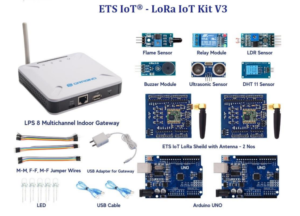
IoT Kit v3 based on LoRaWAN is designed to facilitate beginners and developers to quickly learn LoRa and IoT technology. It help users to turn the idea into a practical application and make the Internet of Things a reality. It is easy to program, create and connect your things everywhere. A number of telecom operators are currently rolling out networks, but because LoRa operates in the open spectrum you can also set up your own network.
IoT kit v3 based on LoRaWAN will show how to build LoRa network, and how to use the network to send data from a LoRa sensor node to various IoT servers. When used as a private LoRa network, the LoRa gateway will connect your other LoRa nodes up to 500 meters ~ 5km however expect up to 10km range (when in line of sight) when connecting your LoRa node to a LoRa gateway!

The ETS IOT WDM board is built around a dual-core ESP32 chip with 4MB of SPI flash onboard, providing both LoRa, LoRaWAN, Wi-Fi and Bluetooth LE via a “3D antenna” on the PCB.
The board’s LoRa support operating at 868MHz with an included SMA antenna.
The board can be programmed using the Arduino development environment, and the example code shows you how to both send and receive data via LoRa.
Flipping the board over there is a battery holder for a 18650 Li-Ion cell, and while a 18650 sort of looks like a “standard” AA battery, it’s significantly different. So don’t make the mistake of substituting in the more common AA battery to try and power the board. They’re not quite the same size, but I’ve seen people attempt this substitution nonetheless.
MCU Specifications:
LoRa Specification:

ETS-IoT Kit – A Platform to Experiment Internet of Things
IoT trainer kit is an all-in-one prototyping platform for sensor-based IoT projects. It’s packed with state of the art sensor technology and ready-to-use software applications, capable of fulfilling all your IoT application needs. It contains inbuilt Raspberry Pi4 with all in one sensor platform to enable infinite IoT application prototype possibilities.
It also has a GPS module to add localization capability for the IoT projects. In addition to that, it consists of Pushbuttons, OLED display, and status LEDs to demonstrate or visualize IoT applications.
Technical Specifications:
On-Board Processor
§ Raspberry Pi 4 – 4GB